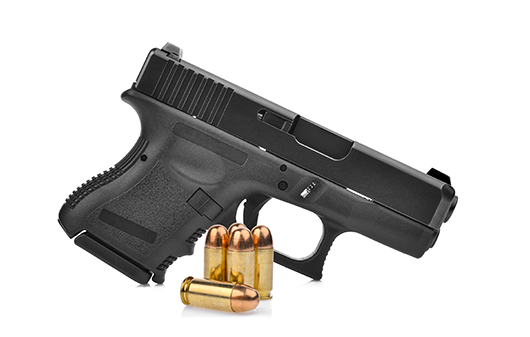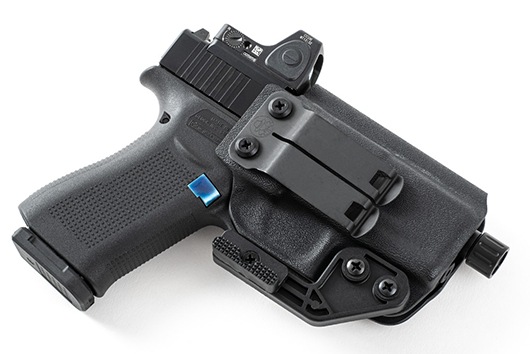How to Choose a Gun Holster for All Seasons
Mar 11th 2021

Carrying a gun for self-defense is a year-long commitment. It doesn’t stop when the weather changes and the temperature rises or falls. You have to adapt your concealed carry needs to climate and seasonal weather changes.
Five factors affect concealability, comfort, and accessibility. They are your firearm choice, carry method/position, gun belt, physique, and wardrobe.
You must choose the right concealed-carry holster that addresses these issues and adapt to seasonal changes.
Choice of Firearm

Your choice of holster depends, to an extent, on what kind of firearm you intend to carry. Some gun owners prefer to carry large-framed, long-barreled firearms in the colder months because they know they’ll be able to comfortably conceal them under a jacket.
Compact or subcompact firearms are highly appropriate for concealed carry, but a full-size service weapon may be the best choice if you intend to open carry.
Carry Method and Position
Your first consideration regarding the holster should be how you intend to carry it. This refers to method and position. If you carry in a waistband holster, there are two methods: OWB and IWB. Position refers to the holster’s location on your waistband and is expressed as an hour on a clock face — e.g., strong side is 3 o’clock.
If you carry your firearm openly, an OWB (outside-the-waistband) holster is your best option. This is your standard belt holster and usually uses loops to securely attach to your belt. You can conceal an OWB holster, but this often requires the use of a covering garment. For concealed carry, an OWB belt holster is among the most comfortable types of holsters to wear when the weather is colder.
IWB (inside-the-waistband) holsters use clips, soft loops, or other devices to attach to your belt, sitting between your waistband and body. Some clips also allow you to attach the holster directly to your trousers’ waistband without a belt. This carry method enables deep concealment, especially with subcompact handguns.
Gun Belt
When you carry a firearm in or outside your waistband, you need a belt that’s stiff and sturdy. Your gun belt should work in conjunction with your holster to support your firearm, resisting sagging or upward pressure. The heavier your gun, the stiffer your gun belt should be to avoid discomfort or disclosing your weapon. A regular dress belt won’t perform to the same standards and may stretch over time.
Pocket Holster
You may have contemplated carrying a subcompact handgun in your pocket, but even pocket carry requires a pocket holster. The holster doesn’t simply help you retain the gun. It also protects the trigger and keeps the gun correctly positioned. Your gun is liable to move inside a pocket or dedicated compartment, reducing access. You don’t want anything you’ve collected in your pockets to interfere with your gun.
Ankle Holster
This type of holster is unsuitable for shorts, but if you want to carry a backup to your primary weapon, an ankle holster can be comfortable. However, an ankle holster is slow to draw from and requires you to crouch or bend over. That’s why this should always remain a secondary or tertiary option.
Shoulder Holster
The shoulder holster is a popular choice among those who spend a considerable amount of their time driving or sitting behind a desk—drawing from a waistband holster while seated can be awkward, especially in a vehicle when you factor in the seatbelt.
Naturally, a shoulder holster is not concealable without using a jacket, limiting its usefulness in warmer climates or during the summer. Even with a coat, others may still be able to see or feel the harness through your clothing.
Regarding training, shoulders are not ideal. Many shoulder holsters point the gun’s muzzle horizontally, which can flag students or instructors behind you. Drawing and reholstering with one hand are also more difficult with this setup.
If you’re thinking of choosing a shoulder holster because you can’t wear a belt, you should consider selecting a device, such as an UltiClip, that can attach directly to your waistband.
Concealability
When choosing a holster for concealed carry, you need to know that you can properly conceal it. While a loose t-shirt can drape over an IWB holster during the summer months, not everyone has the luxury of wearing an untucked shirt. For those dress codes and settings where you have to wear your shirt tucked in, you should investigate belt clips that specifically enable this.
These clips are tuckable — they attach at the bottom of the holster, providing a space into which you can tuck clothing. As a result, your shirt covers the holster and gun, leaving the belt clips exposed.
Some gun owners choose to match the color of the clips to the color of their belt or clothing. You may also want to investigate belt clips that are less conspicuous.
You want a quality holster that doesn’t print. Printing is when the gun or holster produces a visible outline or bulge through your jacket or shirt. Even if the gun’s silhouette is not visible, a sudden break in the line of your clothing can disclose that you have something on your hip. Your average bystander may not notice, but a careful observer will.
Concealment Devices
If you’re dressing lightly for the summer, you may want to consider certain devices to enhance your weapon’s concealability. A mod wing is a type of device that can attach to a holster under or beside the belt clip. Its purpose is to drive the holster into your body and away from your waistband to reduce printing.
Holster Materials
The two most common holster materials are leather and Kydex. Leather holsters are usually made from cowhide or horsehide, but suede and chamois leather holsters are also available. Leather holsters are popular in part because they’re comfortable to wear, mold to your body over time, and have more of a cushioning effect than other materials.
Kydex Holsters
In the summer and when you’re likely to sweat, you want a holster that won’t chafe against your skin or deform due to moisture. Kydex holsters have the advantage of being resistant to moisture and abrasion. This stiff thermoplastic is less likely to chafe in the heat. It’s also more durable and should last longer.
A Word on Retention
It’s important to remember that open-carry holsters, such as those used by law enforcement, often use active-retention devices — e.g., thumb breaks. This type of system introduces another failure point or delay to your draw stroke.
You should consider this type of retention if you carry your firearm openly or an assailant is likely to discover it. That’s one of the risks of open carry — you may be seen as a target of opportunity rather than a potential threat to be avoided.
For a properly concealed IWB holster, passive retention — i.e., the type that uses friction — is sufficient. Leather holsters can provide passive retention, but frequent use can degrade and loosen the stiffness, diminishing the holster’s ability to keep the gun secure.
One great solution to this problem is using a Kydex holster. Kydex is a rigid, water-resistant thermoplastic that retains its shape through prolonged wear, practice drills, and adverse weather.
Safety is Critical
Independent of the climate and season, the holster design should fully enclose the trigger guard. Most unintentional discharges are caused by a failure to properly observe firearms safety rules. However, there’s no harm in reducing the risk of your finger inadvertently entering the trigger guard, whether prematurely during the draw or as you’re reholstering.
You should be able to reholster your firearm without using your support hand. You may cover your hand or forearm with the muzzle. The holster that you choose should remain open at all times. A holster whose mouth collapses when you draw your weapon is a liability.
Furthermore, a holster with loose flaps or that can fray poses a potential safety hazard, eliminating soft leather as a viable choice.
Wardrobe is Important
Your manner of dress is also a factor that affects your choice of holster. If you carry a handgun OWB, you should be prepared to wear a jacket or other cover garment if you want to hide your weapon. For IWB carry, you should choose a pair of pants that can accommodate the additional bulk of a holstered firearm.
If you can’t wear a belt, explore clips or other attachment devices that enable beltless carry. Otherwise, you may have to choose a non-waistband option. If you can, you should avoid off-body carry locations that reduce accessibility and pose a risk of loss due to theft.
Homework and Testing
You should investigate different holster designs and materials and experiment with them. If you can, try them on in different positions. Test them with outfits suitable for all four seasons, and determine which suits you best.
In Conclusion
At Incognito Concealment, we understand your commitment to carrying a firearm all-year-round. However, it’s far easier to adhere to your commitment if you’re carrying your weapon comfortably. An uncomfortable holster deters you from carrying consistently, which defeats the purpose of carrying a gun.
You don’t want to have left it on your nightstand or in your vehicle the one day you need it. If you want to discuss holsters for year-round carry, give us a call at (586) 999-5820.











